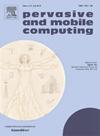Contrastive-representation IMU-based fitness activity recognition enhanced by bio-impedance sensing
IF 3.5
3区 计算机科学
Q2 COMPUTER SCIENCE, INFORMATION SYSTEMS
引用次数: 0
Abstract
While IMU-based Human Activity Recognition (HAR) has achieved significant success in wearable and pervasive computing areas over the past decade, the potential for further improvement of IMU-based HAR performance through the contrastive representation method enhanced by other sensing modalities remains underexplored. In this work, we propose a contrastive representation learning framework to demonstrate that bio-impedance can enhance IMU-based fitness activity recognition beyond the common sensor fusion method, which requires all sensing modalities to be available during both training and inference phases. Instead, in our proposed framework, only the target sensing modality (IMU) is required at inference time. To evaluate our method, we collected both IMU and bio-impedance sensing data through an experiment involving ten subjects performing six types of upper-body and four kinds of lower-body exercises over five days. The bio-impedance-alone classification model achieved an average Macro F1 score of 75.49% and 71.57% for upper-body and lower-body fitness activities, respectively, which was lower than that of the IMU-alone model (83.10% and 78.61%). However, with our proposed method, significant performance improvement (2.66% for upper-body activities and 3.2% for lower-body activities) was achieved by the IMU-only classification model. This improvement leverages the contrastive representation learning framework, where the information from bio-impedance sensing guides the training procedure of the IMU-only model. The results highlight the potential of contrastive representation learning as a valuable tool for advancing fitness activity recognition, with bio-impedance playing a pivotal role in augmenting the capabilities of IMU-based systems.
生物阻抗感知增强基于对比表示imu的健身活动识别
虽然基于imu的人类活动识别(HAR)在过去十年中在可穿戴和普适计算领域取得了重大成功,但通过其他传感模式增强的对比表示方法进一步改善基于imu的HAR性能的潜力仍未得到充分探索。在这项工作中,我们提出了一个对比表征学习框架,以证明生物阻抗可以增强基于imu的健身活动识别,而不是普通的传感器融合方法,这需要在训练和推理阶段提供所有传感模式。相反,在我们提出的框架中,在推理时只需要目标感知模态(IMU)。为了评估我们的方法,我们通过一项实验收集了IMU和生物阻抗传感数据,该实验涉及10名受试者在5天内进行6种上身运动和4种下半身运动。单生物阻抗分类模型对上半身和下半身健身活动的平均Macro F1得分分别为75.49%和71.57%,低于单生物阻抗分类模型的83.10%和78.61%。然而,使用我们提出的方法,仅imu分类模型的性能提高显著(上半身活动为2.66%,下半身活动为3.2%)。这种改进利用了对比表征学习框架,其中来自生物阻抗传感的信息指导了仅imu模型的训练过程。研究结果强调了对比表征学习作为促进健身活动识别的有价值工具的潜力,生物阻抗在增强基于imu的系统的能力方面发挥着关键作用。
本文章由计算机程序翻译,如有差异,请以英文原文为准。
求助全文
约1分钟内获得全文
求助全文
来源期刊

Pervasive and Mobile Computing
COMPUTER SCIENCE, INFORMATION SYSTEMS-TELECOMMUNICATIONS
CiteScore
7.70
自引率
2.30%
发文量
80
审稿时长
68 days
期刊介绍:
As envisioned by Mark Weiser as early as 1991, pervasive computing systems and services have truly become integral parts of our daily lives. Tremendous developments in a multitude of technologies ranging from personalized and embedded smart devices (e.g., smartphones, sensors, wearables, IoTs, etc.) to ubiquitous connectivity, via a variety of wireless mobile communications and cognitive networking infrastructures, to advanced computing techniques (including edge, fog and cloud) and user-friendly middleware services and platforms have significantly contributed to the unprecedented advances in pervasive and mobile computing. Cutting-edge applications and paradigms have evolved, such as cyber-physical systems and smart environments (e.g., smart city, smart energy, smart transportation, smart healthcare, etc.) that also involve human in the loop through social interactions and participatory and/or mobile crowd sensing, for example. The goal of pervasive computing systems is to improve human experience and quality of life, without explicit awareness of the underlying communications and computing technologies.
The Pervasive and Mobile Computing Journal (PMC) is a high-impact, peer-reviewed technical journal that publishes high-quality scientific articles spanning theory and practice, and covering all aspects of pervasive and mobile computing and systems.
 求助内容:
求助内容: 应助结果提醒方式:
应助结果提醒方式:


